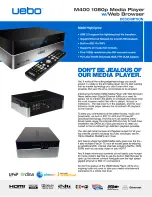
252
Transmission Modes
WAVECOM Decoder W74PC, W-PCI/e, W-CODE, W-CLOUD Manual V9.1.0
Baud Rate
User data rate (bps)
Bits per symbol (M-PSK)
FEC
coding
rate
Interleaver
1200
1200
3 (8-PSK)
2 / 3
SHORT or LONG
1200
600
2 (QPSK)
1 / 2
SHORT or LONG
1200
300
1 (BPSK)
1 / 2
SHORT or LONG
1200
150
1 (BPSK)
1 / 4
SHORT or LONG
1200
75
1 (BPSK)
1 / 8
SHORT or LONG
1200
1800
3 (8-PSK)
uncoded
ZERO
1200
1200
2 (QPSK)
uncoded
ZERO
1200
600
1 (BPSK)
uncoded
ZERO
The user data is transmitted using a continuous frame structure with 213.33 ms per frame. Each frame
starts with a preamble containing 80 symbols. The following 176 symbols are divided into four 32 symbol
data segments and three 16 symbol channel probe segments.
The 176 symbol data probe segment immediately follows a next frame beginning with the same 80 symbol
preamble. This repeated frame structure allows synchronization of the demodulator at any time of trans-
mission.
At the end of transmission, an EOM bit pattern (4B65A5B2, in hexadecimal notation, MSB first) is sent to
mark the end of message. The EOM sequence is followed by flush bits, to flush the FEC coder and to com-
plete the transmission of the remainder of the interleaver data block.
In most cases FEC and interleaving is used to combat the effects of fading, frequency shift, multipath, and
burst noise. User data is in this case first FEC encoded, interleaved, then mapped into PSK symbols and
transmitted in 32 symbol data segments. The 16 symbol channel probe segment transmitted between
each succeeding data segment has a known PSK pattern. Its purpose is to keep the demodulator, mainly
the equalizer, on track in spite of adverse propagation conditions during the HF transmission.
Generally STANAG-4529 transmits the user data in transparent binary mode. This should be defined by
the higher layer using the STANAG 4529 mode. For this reason the decoder displays the user data in BI-
NARY, HEX, ASCII ASYNC, ASCII ASYNC (7 Data bits and No Stop bit) or ASCII SYNC format selected from
Options | Message Type...
. The decoder stops displaying data after the EOM bit pattern is received.
In the HEX display mode, the decoded binary data is just displayed as it is, MSB first.
In ASCII ASYNC mode, the bit stream is correlated with an ASCII ASYNC structure, i.e., one start-bit (0),
8 data bits and at least one stop bit (1). The 8 data bits are displayed LSB first. In addition to the EOM
pattern, the display will stop if more than 300 NULL characters are received or if the asynchronous data
structure is violated more than 80 times.
In ASCII ASYNC (7 data bits and no stop bit) mode, the bit stream is correlated with another ASYNC struc-
ture, i.e., one start bit (0) and 7 data bits. The 7 data bits are displayed LSB first. In addition to the EOM
pattern, the display will stop if more than 300 NULL characters are received.
In ASCII SYNC mode, each 8 bits (LSB first) represent one ASCII character. The display will stop if the
EOM pattern is received or if more than 20 NULL characters are received.
16
16
16
32
32
32
32
80
80
Block 1
Block 2
Block 3
Block 4
T = 213.33 ms
80
16
32
Preamble symbols
Data symbols
Channel probe symbols
Preamble














































